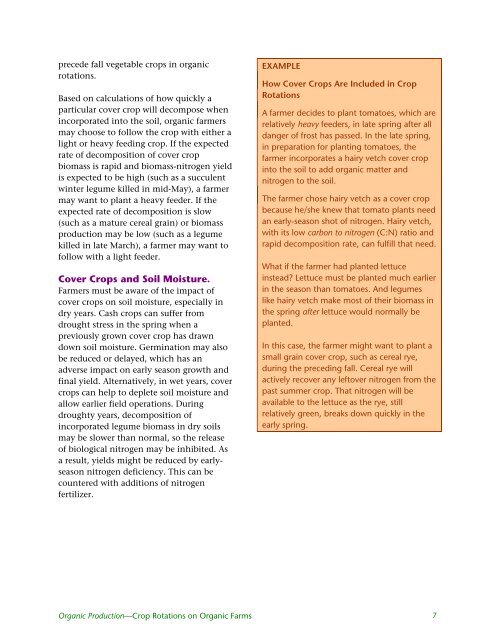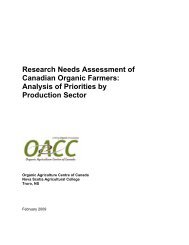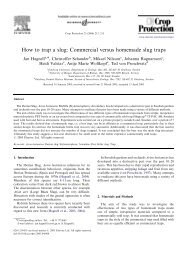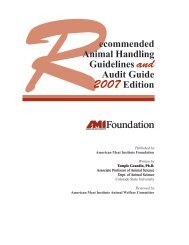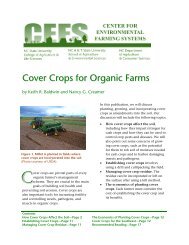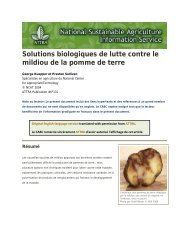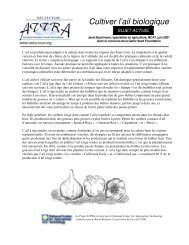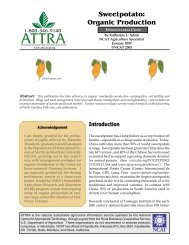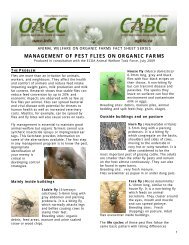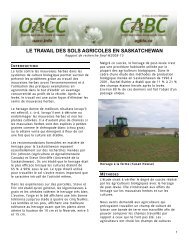<strong>Organic</strong> farmers have reported manybeneficial effects from crop rotati<strong>on</strong>s <strong>on</strong>phosphorous relati<strong>on</strong>ships in the soil.According to these farmers, crop plantsraised in rotati<strong>on</strong>s generally have betterroot functi<strong>on</strong>, and so are better able to takeup phosphorous from the soil. The farmerspoint out that rotati<strong>on</strong>s employing greenmanures have a tendency to increase soilmicrobial activity, as well as plant-availablephosphorous. Finally, the enhancednutrient cycling that results from croprotati<strong>on</strong>s increases the amount of twoplant-available forms of phosphorous in thesoil: biomass phosphorous and labileorganic phosphorous.<str<strong>on</strong>g>Crop</str<strong>on</strong>g> <str<strong>on</strong>g>Rotati<strong>on</strong>s</str<strong>on</strong>g> Boost N, C, P, and K in SoilsA team of researchers reported in a 1998 issueof Agr<strong>on</strong>omy Journal that the use of rotati<strong>on</strong>alorganic farming practices over an eight-yearperiod increased soil organic carb<strong>on</strong>, solublephosphorous, exchangeable potassium, andsoil pH (acidity measurements).At the c<strong>on</strong>clusi<strong>on</strong> of the eight-year trial, soilorganic carb<strong>on</strong> was 2 percent higher in a fieldwhere organic rotati<strong>on</strong>al practices were usedthan in a baseline field where c<strong>on</strong>venti<strong>on</strong>alpractices and a two-year rotati<strong>on</strong> scheme wasused. Likewise, total soil nitrogen was 22percent higher in the organic field than in thebaseline c<strong>on</strong>venti<strong>on</strong>al field.Source: Clark et al. (1998)Light and Heavy Feeders<strong>Organic</strong> farmers often base their croprotati<strong>on</strong>s <strong>on</strong> whether various plants in therotati<strong>on</strong>al lineup are light or heavy feeders.<str<strong>on</strong>g>Crop</str<strong>on</strong>g>s differ in their ability to extract waterand nutrients from the soil. Some plantswith shallow roots feed near the surface;others have root systems that explore thesoil at lower depths (Table 1). Following ashallow-rooted crop like <strong>on</strong>i<strong>on</strong>s or carrots,organic farmers may plant deeper-rootedcrops like corn to recover nutrients thatwere unused by the shallow feeders andmay have leached by irrigati<strong>on</strong> or rainfallto lower depths in the soil profile.C<strong>on</strong>versely, these farmers sometimes followdeep-rooted heavy feeders with shallowrootedlight feeders to scavenge nutrientsthat may remain after heavy applicati<strong>on</strong>s ofnutrients.Examples of Light and Heavy FeedersSome crops are heavyfeeders that deplete soils,while other crops are lightfeeders that build soils.Soil Depleting <str<strong>on</strong>g>Crop</str<strong>on</strong>g>sRow crops — corn, soybeans, vegetables,potatoesSoil Neutral or Soil C<strong>on</strong>serving <str<strong>on</strong>g>Crop</str<strong>on</strong>g>sCereal crops — wheat, barley, oatsSoil Building <str<strong>on</strong>g>Crop</str<strong>on</strong>g>sLegume sods — alfalfa, cloverGrass sods — prairie grass, meadows, pasturesCover <str<strong>on</strong>g>Crop</str<strong>on</strong>g>sWarm-seas<strong>on</strong> legumes, grown as covercrops, figure prominently in every rotati<strong>on</strong><strong>on</strong> an organic farm. This is because they area primary source of nitrogen for other cropsin the organic rotati<strong>on</strong>. In most years,growing a winter legume like hairy vetch orcrims<strong>on</strong> clover will provide all thebiological nitrogen necessary for a summercash crop. Warm-seas<strong>on</strong> legumes likecowpeas, sunnhemp or soybeans also offeropportunities for biological nitrogenfixati<strong>on</strong> during the summer seas<strong>on</strong>.Legumes often follow spring crops or<strong>Organic</strong> Producti<strong>on</strong>—<str<strong>on</strong>g>Crop</str<strong>on</strong>g> <str<strong>on</strong>g>Rotati<strong>on</strong>s</str<strong>on</strong>g> <strong>on</strong> <strong>Organic</strong> <strong>Farms</strong> 6
precede fall vegetable crops in organicrotati<strong>on</strong>s.Based <strong>on</strong> calculati<strong>on</strong>s of how quickly aparticular cover crop will decompose whenincorporated into the soil, organic farmersmay choose to follow the crop with either alight or heavy feeding crop. If the expectedrate of decompositi<strong>on</strong> of cover cropbiomass is rapid and biomass-nitrogen yieldis expected to be high (such as a succulentwinter legume killed in mid-May), a farmermay want to plant a heavy feeder. If theexpected rate of decompositi<strong>on</strong> is slow(such as a mature cereal grain) or biomassproducti<strong>on</strong> may be low (such as a legumekilled in late March), a farmer may want tofollow with a light feeder.Cover <str<strong>on</strong>g>Crop</str<strong>on</strong>g>s and Soil Moisture.Farmers must be aware of the impact ofcover crops <strong>on</strong> soil moisture, especially indry years. Cash crops can suffer fromdrought stress in the spring when apreviously grown cover crop has drawndown soil moisture. Germinati<strong>on</strong> may alsobe reduced or delayed, which has anadverse impact <strong>on</strong> early seas<strong>on</strong> growth andfinal yield. Alternatively, in wet years, covercrops can help to deplete soil moisture andallow earlier field operati<strong>on</strong>s. Duringdroughty years, decompositi<strong>on</strong> ofincorporated legume biomass in dry soilsmay be slower than normal, so the releaseof biological nitrogen may be inhibited. Asa result, yields might be reduced by earlyseas<strong>on</strong>nitrogen deficiency. This can becountered with additi<strong>on</strong>s of nitrogenfertilizer.EXAMPLEHow Cover <str<strong>on</strong>g>Crop</str<strong>on</strong>g>s Are Included in <str<strong>on</strong>g>Crop</str<strong>on</strong>g><str<strong>on</strong>g>Rotati<strong>on</strong>s</str<strong>on</strong>g>A farmer decides to plant tomatoes, which arerelatively heavy feeders, in late spring after alldanger of frost has passed. In the late spring,in preparati<strong>on</strong> for planting tomatoes, thefarmer incorporates a hairy vetch cover cropinto the soil to add organic matter andnitrogen to the soil.The farmer chose hairy vetch as a cover cropbecause he/she knew that tomato plants needan early-seas<strong>on</strong> shot of nitrogen. Hairy vetch,with its low carb<strong>on</strong> to nitrogen (C:N) ratio andrapid decompositi<strong>on</strong> rate, can fulfill that need.What if the farmer had planted lettuceinstead? Lettuce must be planted much earlierin the seas<strong>on</strong> than tomatoes. And legumeslike hairy vetch make most of their biomass inthe spring after lettuce would normally beplanted.In this case, the farmer might want to plant asmall grain cover crop, such as cereal rye,during the preceding fall. Cereal rye willactively recover any leftover nitrogen from thepast summer crop. That nitrogen will beavailable to the lettuce as the rye, stillrelatively green, breaks down quickly in theearly spring.<strong>Organic</strong> Producti<strong>on</strong>—<str<strong>on</strong>g>Crop</str<strong>on</strong>g> <str<strong>on</strong>g>Rotati<strong>on</strong>s</str<strong>on</strong>g> <strong>on</strong> <strong>Organic</strong> <strong>Farms</strong> 7


